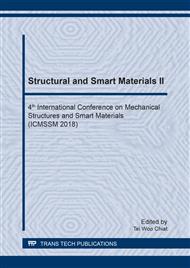[1]
M.B.J.G. Freitas, E.M. Garcia. Electrochemical recycling of cobalt from cathodes of spent lithium-ion batteries. Journal of Power Sources, 171(2007) 953-959.
DOI: 10.1016/j.jpowsour.2007.07.002
Google Scholar
[2]
G. Dorella, M.B Mansur. A study of the separation of cobalt from spent Li-ion battery residues. Journal of Power Sources, 170(2007) 210-215.
DOI: 10.1016/j.jpowsour.2007.04.025
Google Scholar
[3]
H. B. He, Y. H. Qin, Application of organic solvent partition method on used lithium-ion batteries, Chinese Journal of Power Sources. 30(2006) 380-382, 390.
Google Scholar
[4]
Information on http://www.cnhubei.com.
Google Scholar
[5]
C. L. Li, Y. C. Xie, X. F. Li, Research progress in preparation and modifaication of lithium ion phosphate anode material, New Chemical Materials. 46(2018) 25-28, 33.
Google Scholar
[6]
C. J. Yu, X. Y. Mo, C. R. Kang, et al, Progress in Synthesis and Modification of LiFePO4 Cathode Material for Lithium Ion Rechargeable Batteries, Journal of Materials Science& Engineering. 29(2011) 454, 468-470.
Google Scholar
[7]
Z. J. Jiang, Development and challenge of LiFePO4 cathode materials for Li-ion batteries, Journal of Functional Materials. 41(2010) 365-368.
Google Scholar
[8]
Z. R. Xu, L. B. Gao, Y. J. Liu, et al. Review—Recent Developments in the Doped LiFePO4 Cathode Materials for Power Lithium Ion Batteries. Journal of the Electrochemical Society, 163(2016) 2600-2610.
DOI: 10.1149/2.0411613jes
Google Scholar
[9]
N. F. Cheng, T. Li, The Study of Cathode Materials LiFePO4/C for Lithium Battery, Guangzhou Chemical Industry. 39(2011) 62-63, 78.
Google Scholar
[10]
G. B. Feng, H. Deng, Research progress of cathode material LiFePO4 for Li-ion battery, Inorganic Chemicals Industry. 43(2011) 14-17.
Google Scholar
[11]
K. Y. Zhang, Y. C. Yao, Research progress in LiFePO4 cathode material for lithium-ion batteries, Chemical Industry and Engineering Progress. 34(2015) 166-172.
Google Scholar
[12]
Y. C. Qiao, R. K. Chen, H. H. Tang, et al, Comprehensive Recovery of Phosphorus, Iron and Lithium from Spent Lithium Iron Phosphate Batteries, Mining and Metallurgical Engineering. 38(2018) 118-122.
Google Scholar
[13]
Y. H. Xie, H. J. Yu, Y. N. Ou, et al, Recovery and preparation of LiFePO4 from used traction battery, Chinese Journal of Power Sources. 38(2014) 2239-2241, 2257.
Google Scholar


